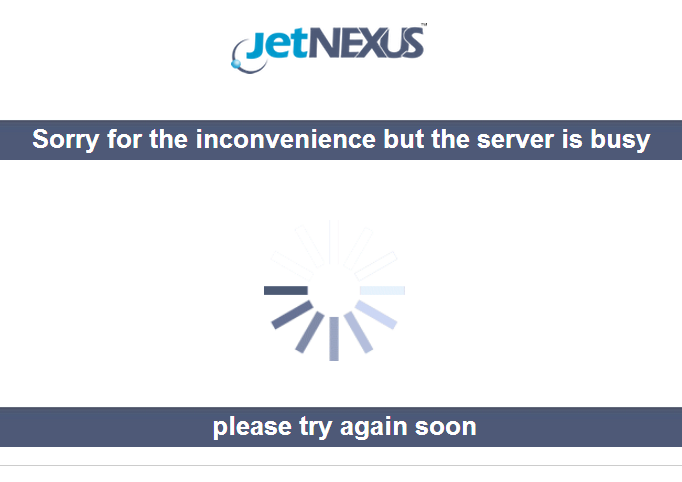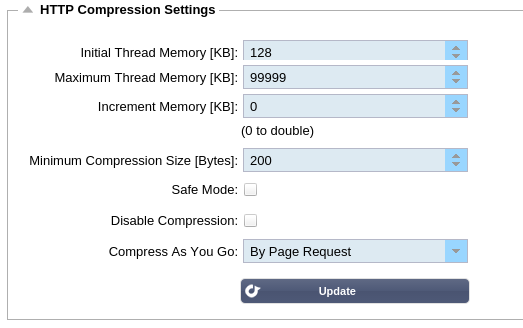HTTP
The Advanced–>Protocol–>HTTP
page allows you to set advanced settings for HTTP.
The page is organised into the section below.
Server Too Busy
If you have limited the maximum connections to your real servers you can choose to present a friendly web page once this limit has been reached.
- Create a simple web page with your message. You may include external links to objects on another web server. Alternatively if you want to include images on your web page then use inline base64 encoded images
- Browse for your newly created web page
- Click Upload
- If you wish to preview the page you can do so with the Click Here link

Example of Server Too Busy page

Forwarded For
Forwarded for is the de facto standard for identifying the originating IP address of a client connecting to a web server through layer-7 load balancers and proxy-servers.
Forwarded-For Output:
Off:
Add Address and Port:
Add Address:
Replace Address and Port:
the Forwarded-For header with the IP address and port of the
device or client connected to jetNEXUS ALB-X.
Replace Address:
Forwarded-For Header:

Advanced Logging for IIS – Custom Logging
Field called X-Forwarded-For with the settings below
From the Category list, select Default
From the Source Type list, select Request Header
In the Source Name box, type X-Forwarded-For
http://www.iis.net/learn/extensions/advanced-logging-module/advanced-logging-for-iis-custom-logging
Apache httpd.conf changes
- LogFormat: “%h %l %u %t \”%r\” %>s %b \”%{Referer}i\” \”%{User-Agent}i\”” combined
- LogFormat: “%{X-Forwarded-For}i %l %u %t \”%r\” %>s %b \”%{Referer}i\” \”%{User-Agent}i\”” proxy SetEnvIf X-Forwarded-For “^.*\..*\..*\..*” forwarded
- CustomLog: “logs/access_log” combined env=!forwarded
- CustomLog: “logs/access_log” proxy env=forwarded
This format takes advantage of apache’s built-in support for conditional logging based upon environment variable.
- The first line is the standard combined log formatted string from the default.
- The second line replaces the %h (remote host) field with the value(s) pulled from the X-Forwarded-For header and sets the name of this log file pattern to “proxy”.
- Line 3 is a setting for environment variable “forwarded” that contains a loose regular expression matching an ip address, which is ok in this case since we really care more whether an ip address exists in the X-Forwarded-For header. Explained another way, line 3 could be read as: “If there is an X-Forwarded-For value, use it.”
- Lines 4 and 5 tell apache which log pattern to use. If and X-Forwarded-For value exists, use the “proxy” pattern, else use the “combined” pattern for that request. For readability, lines 4 and 5 do not take advantage of Apache’s rotatelogs (piped) logging feature but I assume that it is in use by most everyone.
These changes should result in logging an IP address for every request.
HTTP Compression Settings
Compression is an acceleration feature and is enabled for each Service on the IP Services page.
WARNING – Take extreme care when adjusting these settings as inappropriate settings can adversely affect the performance of jetNEXUS ALB-X
Initial Thread Memory [KB]:
Maximum Thread Memory [KB]:
Increment Memory [KB]:
ALB-X will double the allocation when the data exceeds the current allocation (e.g. 128Kb, then 256Kb, then 512Kb, etc) up to the limit set by Maximum Memory Usage per Thread. This is efficient where the majority of pages are of a consistent size but there are occasional larger files. (e.g. Majority of pages are 128Kb or less, but occasional responses are 1Mb in size.) In the scenario where there are large variable sized files, it is more efficient to set a linear increment of a ignificant size (e.g.Responses are 2Mb to 10Mb in size, an initial setting of 1Mb with increments of 1Mb would be more efficient.).
Minimum Compression Size [Bytes]:
Safe Mode:
Disable Compression:
Compress As You Go:
On:
Off:
By Page Request:

Global Compression Exclusions
Anything added to the current exclusion list will not be compressed.
- Type in the individual file name.
- Click update.
- If you wish to add a file type simply type “*.css” for all cascading style sheets to be excluded.
- Each file or file type should be added on a new line.

 Back to
Back to
Top